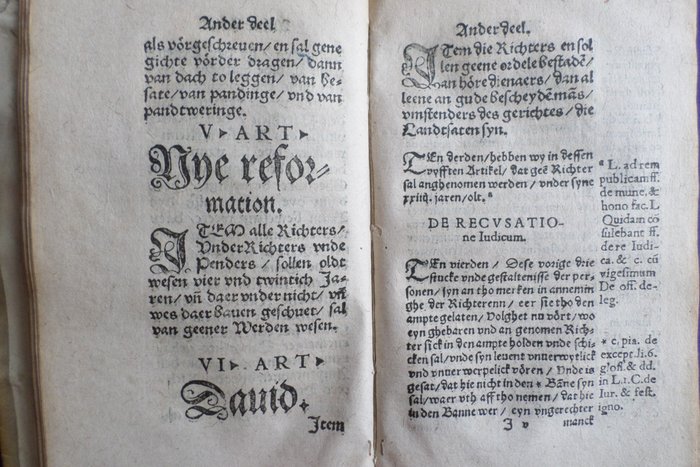
Melchior Winhoff’s Book of Laws, the Landtrecht van Averissel
When the government of Emperor Charles V called for all the provinces of the Low Countries to record and publish their regional laws, the newly-formed province of Overijssel was unready to do so. That's when a local lawyer named Melchior Winhoff stepped up.
How did sixteenth-century judges, lawyers, rulers, baliffs, and noblemen know what the law is? What is legal? What is permissible? What is not?
Though legal scholars looked to the civil laws of Ancient Rome, the Corpus iuris civilis, and attempted to adapt it to contemporary circumstances, these interpretations were not always uniform – nor were they well recorded. Making the situation more complex was the difficult nature of travel and regional distinctions: your interpretation of the law may not be the same as how we interpret it in my province.
Knowing the law become a murky, esoteric matter at the best of times.
This was the situation facing Charles V – Holy Roman Emperor, King of the united Spanish kingdom, and ruler of most of the Low Countries – in the early decades of his rule.
He worked diligently – both militarily and administratively – to being the hard work of expanding, centralizing, and modernizing his vast holdings. While by 1540 he was still at war with William the Rich, Duke of Geulders, to gain control over all of the Low Countries, his government had already begun influencing the provincial governments that lay within his realm.
In 1540, the government in Brussels, the the seat of government and Charles’ primary court in the region, ordered the provincial courts to make a collection of all their respective laws.
Some did that. Others didn’t. Some provinces made an attempt.
Overijssel was a province just coming into its own. It was once the “over the IJssel River” territory of the Prince-Bischopric of Utrecht, which had been sectioned off by the Habsburgs into its own Lordship only a few decades earlier.
The provincial court of Overijssel did not formally commission and pay for the printing of a collection of its laws, but a local lawyer named Melchior Winhoff took on the work.
It’s unknown if it was of his own initiative or at the behest of the provincial governor (the “stadhouder”) which Charles V had installed in 1549. That man was Jan van Ligne, the Count of Aremberg, and it was to him the book was dedicated.

The “Landtrecht van Averissel” was printed in 1559 and was particularly interesting as it was written not in Latin, but in the local vernacular, a Dutch Low Saxon which lays linguistically between Brabanter Dutch (which evolved into standard Dutch) and the Low German tongue in the lands further to the east.
It is a relatively small octavio-sized book, bound in parchment. The title page is beautifully printed in red and black in by the presses of Simon Steenbergen in Deventer (although the title page does not have his printer’s device).

Melchior’s work would remain the standard reference of the laws of the province for the next seventy years, when an updated and enlarged version was published officially by the provincial government in 1630.
Cover photo courtesy of the Oudheidkamer Twente website:
OudheidkamerTwente.nl
Interior Photos courtesy of a recent auction:
https://www.catawiki.com/l/1730007-topography-melchior-winhoff-landtrecht-van-averissel-thosamen-gebracht-unde-uthgelecht-1559
The “Landtrecht van Averissel” in full:
https://books.google.com/books?id=ryEyNgJf14cC
